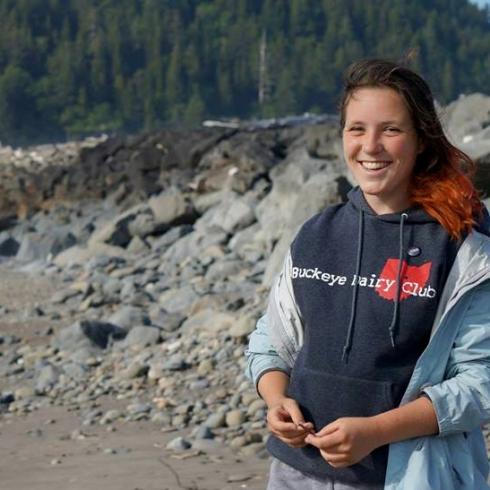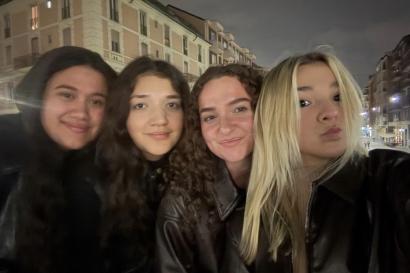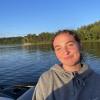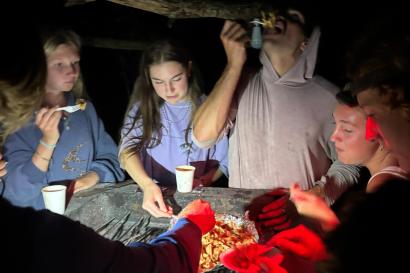How would I summarize my hike through the Andes? A handful of plant snot.

Check that mucus. (Photo credit Amanda Stasiewicz.)
And I mean that in the best way possible. Our hike through Paluguillo was the most beautiful experience of my life. Scooping up handfuls of plant snot was only one of many experiences I won’t forget.
We started our hike in the Super Páramo ecosystem at 14,107 feet of elevation. (And we Americans think 14,000 foot mountains are high!) We stepped off the bus into a veil of misty cloud. I would call it fog, but when you’re up that high I think you are actually inside a rain cloud. We all dressed warmly, but I wasn’t expecting the ice which kept chipping off the cell towers and landing on us!

On top of the world.
The vegetation at this altitude is fascinating. The dominant flora is the cushion plant. It’s an aggregation of individual plants which live on a heap of their decaying ancestors for warmth, a phenomenon known as dead biomass accumulation. Contrary to their name, cushion plants are hard as rocks. They can live for hundreds of years!

700-year-old cushion plants.
Whereas competition between species predominates in lower ecosystems such as the tropical rain forest, in the Páramo plants must cooperate to withstand the freezing temperatures and intense UV light.

Three moss species are visible within this cushion plant.
Even in this pristine wilderness, patches of bare mud remain exposed. The elements are too harsh to allow continuous vegetation. We slipped and slid down the mountainside until we reached the next zone, Grassland Páramo.

A cold lake fills a glacier-carved valley.
This ecosystem is dominated by tussock-forming grasses. The climate is slightly more forgiving, but the main task of all plants is still to keep warm. Like the cushion plants, these grasses hold onto their dead leaves to capture the heat of decomposition. Eighty percent of the Páramo is dead!
The nodding capitula is a signature flower of this region. Its young buds point up, but they begin to droop with age. Mature blossoms hang upside down to create a warmer, more inviting environment for pollinators.

A yellow nodding capitula.
We stopped for lunch next to Parcacocha Lake. Here I saw the first signs of animal life: a small white butterfly flushed from the grass, mud flies landing on our jackets, birdsong. Our professor, Esteban, pointed out the chirps of the estrellita, the highest-altitude hummingbird in the world. A curikinga, halfway between eagle and falcon, glided overhead. An antpitta called grantaria sang from the hills. A chungui from the genus Cinclodes swooped above the reeds. Suddenly I noticed a speck in the middle of the lake! Could it be a duck? With my camera’s incredible zoom (thanks Dad) I could identify it as a grebe — a bird Esteban had never seen here before!

Unidentified grebe in Parcacocha Lake.
When we resumed hiking, we began noticing furry scat and cat-like footprints in the mud of our trail. “Puma!” proclaimed my classmate Tom. “Nah, I’m totally lying,” he admitted, laughing. A few steps later, our professor pulled the group aside to point out a set of prints. “Puma,” he reported solemnly.

Our professor points to fur-filled puma scat with his walking stick.

Our puma’s last meal, perhaps?
Pumas weren’t our only friends on the trail. Fox tracks were also visible heading in both directions. You can easily tell the difference: dog prints show the nails, cat prints don’t. That, and puma tracks are bigger.

From left to right: fox, puma, human.
We soon descended into swampy wetlands, many of us stepping on innocuous-appearing tufts of grass and sinking knee-deep in mud. We stumbled upon a crystal-clear pond whose banks of firm, emerald moss descended beneath the surface like amphibious matter, equally at home in air or water. We stood gazing at the magical pond in awe. “This isn’t real life,” my classmate Laura said to herself.

Swampy Páramo wetlands make for muddy hikers.
Preserving the Páramo is of utmost importance for more than its natural beauty. This ecosystem provides clean water to the millions of inhabitants of Quito, as well as other major cities in Ecuador and Colombia. Without the tussock grasses, frigid lakes, and squelchy peat bogs of the Páramo, rain would erode the exposed dirt and disappear down the slopes.
After the wetlands, we finally descended into Sub Páramo. Forested, biodiverse, moist, hilly — all correct adjectives, all incomplete. The missing word is “magical.”

At the ecotone between Grassland and Sub Páramo.
I spent my childhood camping in the Hoh Rainforst, the most beautiful place on earth. But last Friday I discovered a new contender for the title. The Sub Páramo supports two species of trees, dwarfed by altitude and bent under the weight of epiphytes. Alas, my camera ran out of battery by this point, so I will have to describe the scene in words. Neither words nor photos could do the place justice.
Imagine an elfin forest, bathed in perpetual mist. Trees begin to grow at an invisible line on the mountainside, transforming an unbroken sea of golden grass into a dense jungle. Each tree stands no more than 10 feet high, but each may be hundreds of years old. On closer inspection, you realize the trees are not actually visible. Each gnarled branch supports a load of epiphytes 12 inches thick: mosses, lichens, bromeliads, ferns, flowers, even parasitic shrub saplings. It’s no wonder the trees are hunch-backed. The density of life is palpable. If you try to enter the forest, you feel the wet fingers of plants softly pushing you back to the path. Thin shafts of light give the tantalizing illusion of fairy tunnels penetrating the understory, but clearly no human can enter this pygmy forest. We can only admire flowers on the edge and dream of the contents within.

Nina Finley
<p><span style="color: rgb(29, 29, 29); font-family: Arial, Verdana, sans-serif; font-size: 12px; line-height: normal; background-color: rgb(237, 237, 237);">Nina Finley is a sophomore at The Ohio State University. She ventured to the Midwest from her hometown of Seattle, Washington to major in Animal Sciences and Evolution & Ecology. She would like to become a livestock vet or marine biologist. When she’s not studying, Nina loves to play ultimate frisbee, watch birds and raise meat rabbits. She’s passionate about agriculture, nature and Spanish, all of which she hopes to explore in Ecuador. Join the journey as Nina traces Darwin’s path and explores the natural wonders of the Galapagos Islands!</span></p>







